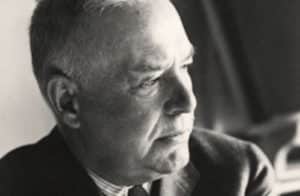< Return to Wallace Stevens Poems
Architecture for the Adoration of Beauty
I
What manner of building shall we build for
the adoration of beauty?
Let us design this chastel de chastete,
De pensee . .
Never cease to deploy the structure . . .
Keep the laborers shouldering plinths . . .
Pass the whole of life earing the clink of the
chisels of the stone-cutters cutting the stones.
II
In this house, what manner of utterance shall
there be?
What heavenly dithyramb
And cantilene?
What niggling forms of gargoyle patter?
Of what shall the speech be.
In that splay of marble
And of obedient pillars?
III
And how shall those come vested that come there?
In their ugly reminders?
Or gaudy as tulips?
As they climb the stairs
To the group of Flora Coddling Hecuba?
As they climb the flights
To the closes
Overlooking whole seasons?
IV
Let us build the building of light.
Push up the towers
To the cock-tops.
These are the pointings of our edifice.
Which, like a gorgeous palm.
Shall tuft the commonplace.
These are the window-sill
On which the quiet moonlight lies.
V
How shall we hew the sun.
Split it and make blocks.
To build a ruddy palace?
How carve the violet moon
To set in nicks?
Let. us fix portals. East and West,
Abhorring green-blue North and blue-green South.
Our chiefest dome a demoiselle of gold.
Pierce the interior with pouring shafts.
In diverse chambers.
Pierce, too, with buttresses of coral air
And purple timbers.
Various argentines.
Embossings of the sky.
VI
And, finally, set guardians in the grounds.
Gray, grewsome grumblers.
For no one proud, nor stiff.
No solemn one, nor pale.
No chafferer, may come
To sully the begonias, nor vex
With holy or sublime ado
The kremlin of kermess.
VII
Only the lusty and the plenteous
Shall walk
The bronze-filled plazas
And the nut-shell esplanades.
—Wallace Stevens
About Wallace Stevens
Wallace Stevens was born on October 2, 1879, in Reading, Pennsylvania and died on August 2, 1955, in Hartford, Connecticut. He won two National Book Awards and the Pulitzer Prize for poetry, along with the Bollingen Prize and the Frost Medal. He was one of the American poets who were considered the high priests of literary modernism, along with T.S. Eliot, William Carlos Williams, and Robert Frost. He was a presence in poetry for more than four decades and had an enormous impact on poetry’s substance and direction.

Wallace Stevens
Stevens, an impressive intellect, was both a poet and a kind of philosopher of aesthetics. The two can’t really be separated. He explored aesthetics as much as if not more than most other subjects. As a young man working in New York City after his graduation from Harvard, he was strongly influenced not only by poets but also by the contemporary art scene. He was in his early 30s when the New York Armory Show rocked the art world (and the American public) in 1913. He was friends with artists like Marcel Duchamp and Man Ray and poets like William Carlos Williams.
Wallace Stevens was also a businessman. He first tried his hand at journalism, turned to law school, and then took his law degree to the insurance industry. After working with a number of smaller firms, he eventually joined the Hartford Insurance Company, where he worked until his death in 1955.
His work required him to travel extensively, all over the eastern United States, the Midwest, and Texas, and he maintained a blistering travel schedule for a long time. The schedule had occasional benefits to his poetry, such as stopping by the offices of Harriet Monroe at Poetry magazine when he was in Chicago. But while he was often encouraged to teach or pursue a more academic profession, he chose to stay with his insurance company, eventually reaching the office of vice president of the Surety Division.
As for Wallace Stevens the family man, the portrait is less flattering. His parents did not attend his marriage to Elsie in their hometown of Reading, Pennsylvania, as they did not consider it a suitable match. He broke with his father over it, and he didn’t see him again until his father’s funeral. He was not especially close to his two brothers or his two sisters, but he would grow closer to their children after his siblings’ deaths. As for his relationship with his wife, while there’s not even a wisp of a rumor of unfaithfulness, it’s clear that Stevens was unhappy in his marriage. Elsie rarely traveled with him, even for vacations; Stevens loved his trips with his drinking friends to Key West and similar points south. And his drinking often begat boorish behavior, such as when he insulted Ernest Hemingway and paid for it with black eyes.
Stevens left behind an extensive writing record: eight poetry collections published during his lifetime, including The Collected Poems, published in 1954 (which won both the National Book Award and the Pulitzer Prize), and a collection of essays, The Necessary Angel (1951). Works published after his death include Opus Posthumous (1957), Collected Poetry and Prose published by the Library of America in 1997, and Selected Poems published by Alfred A. Knopf in 2009. His daughter Holly Stevens also edited his letters, published in 1966.
Stevens was a major presence in American poetry and letters. He was often controversial but never boring. He wrote in the flood time of literary modernism and helped shape it and channel it.
(bio by Glynn Young)
